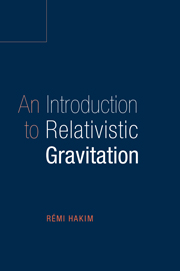Book contents
- Frontmatter
- Contents
- Preface
- 1 NEWTONIAN GRAVITATION
- 2 MINKOWSKI SPACE–TIME
- 3 THE RELATIVISTIC FORM OF PHYSICAL LAWS
- 4 GRAVITATION AND SPECIAL RELATIVITY
- 5 ELECTROMAGNETISM AND RELATIVISTIC HYDRODYNAMICS
- 6 WHAT IS CURVED SPACE?
- 7 THE PRINCIPLE OF EQUIVALENCE
- 8 EINSTEIN'S RELATIVISTIC GRAVITATION (GENERAL RELATIVITY)
- Appendix A Tensors
- Appendix B Exterior Differential Forms
- Appendix C Variational Form of the Field Equations
- Appendix D The Concept of a Manifold
- References
- Physical Constants
3 - THE RELATIVISTIC FORM OF PHYSICAL LAWS
Published online by Cambridge University Press: 05 June 2012
- Frontmatter
- Contents
- Preface
- 1 NEWTONIAN GRAVITATION
- 2 MINKOWSKI SPACE–TIME
- 3 THE RELATIVISTIC FORM OF PHYSICAL LAWS
- 4 GRAVITATION AND SPECIAL RELATIVITY
- 5 ELECTROMAGNETISM AND RELATIVISTIC HYDRODYNAMICS
- 6 WHAT IS CURVED SPACE?
- 7 THE PRINCIPLE OF EQUIVALENCE
- 8 EINSTEIN'S RELATIVISTIC GRAVITATION (GENERAL RELATIVITY)
- Appendix A Tensors
- Appendix B Exterior Differential Forms
- Appendix C Variational Form of the Field Equations
- Appendix D The Concept of a Manifold
- References
- Physical Constants
Summary
There is no purely internal physical experiment which will demonstrate the relative motion of a Galilean reference system – this is the principle of relativity. It follows that all physical laws must necessarily have the same form in all inertial systems (see Chapter 2). To express this property in a simple analytic way, and to avoid the need to show explicitly in each case that the principle of relativity is satisfied, it is extremely useful to write the equations of physics in a form which is manifestly covariant under Lorentz transformations. Not only do we avoid the need for such proofs (often very delicate, and subject to error), but this also allows us to set physics in the context of space-time furnished with a pseudo-metric. Further, the need for manifest covariance of the analytic formulation of a physical phenomenon restricts its possible forms. For this reason we shall use various representations of the Lorentz group: spinors, tensors, etc.
Tensor formalism
(1) Unless otherwise stated, we shall only use cartesian coordinates which are orthogonal in the sense of the metric on M. They thus have a timelike axis Ox0 and three spacelike axes Oxi (i = 1, 2, 3) orthogonal in pairs, in the sense of the metric of R3; these three spatial axes are orthogonal to the axis Ox0, the time axis, in the sense of the metric of Minkowski space (Fig. 3.1).
- Type
- Chapter
- Information
- An Introduction to Relativistic Gravitation , pp. 68 - 94Publisher: Cambridge University PressPrint publication year: 1999



